Click on this link to download an Adobe Acrobat version which you can print out E2EYear6Weeks46-Year7Weeks5.pdf
You can click on the photos to see larger versions
Easter hares, sun-drenched flea-markets and canopied terraces of diners outside the Saint Alexis are my memories of Easter 2007. We were looking forward to an equally festive Easter 2008. My old school-friend Jessica flew over before Easter, and we planned to pick up her husband, Mark, on Good Friday from his mathematical conference in the Black Forest. We envisaged driving through the vineyards on either side of the Rhine, perhaps stopping for a riverside lunch, crossing the Rhine on a small ferry boat and exploring a bit of the Black Forest. We’d had some light snow, so had taken some pretty walks in the hills on the Wednesday and Thursday. But throughout Thursday the predictions of high winds and more snow became increasingly worrying. During that night, as the winds strengthened, we could hear the trees tossing violently. We awoke to find more snow falling and very poor visibility. Over the hot cross buns which John had made the day before (not a local tradition) we decided that the roads would be hazardous, the countryside views shrouded in cloud, and any exploration damp and windswept. So Mark was consigned to the “safe, comfortable and reasonable” Deutsch Bahn/SNCF via Strasbourg to Saint-Dié.
On Easter Sunday, we’d planned to lunch at the restaurant Belle Vue in Saulxures. By then the wind had dropped and the snowscapes were inviting. We hadn’t been there for a while, so hoped it would come up to standard, as our visitors had recently been wined and dined at top London restaurants. We had a patchwork of memories of the Belle Vue with different friends and family, including a leisurely sunny summer meal out on the decking with a huge French family table next to us, presided over by grandfather, with children chasing round afterwards. This time, with the snow all round, and Easter Sunday being a popular day for family meals out, all available downstairs rooms were packed with tables, and lots of well trained extra young waiters and waitresses had been drafted in. They still managed to keep the air of an elegant but friendly family hotel (perhaps it was aided by the new décor, with paintings based on old hotel and staff photographs, bills and publicity). The special Easter Day menu was a five course one, with a choice of two dishes for each course. Just to make your mouth water, after a mackerel pate pre-starter, we all had the foie gras with apple and endive starter, then I had some delicious black tiger prawn kebabs with pastrami and ginger vinaigrette and the others had scallops. The main course was veal with broad beans or stuffed lamb and white beans and then came some tasty goats’ cheese. The desert was a chocolate and almond slice with caramel ice-cream or a pineapple strudel with yoghurt sorbet. The coffee came on their trade-mark wooden tray with two different coffees (arabica and arabica-robusta) each. As you can imagine, it was a delightfully leisurely affair.
On the way back we stopped in the old but run-down village of Senones for a short post-prandial stroll and then drove back through beautiful rolling snowscapes in the late afternoon sunshine. In fact the snow at that height was so beautiful, that on Easter Monday Mark and Jessica set off on a 10km walk up to the blanketing snow around the forest chapel of Sainte Claire and the old fortress at Spitzemberg.
It was a good thing that we had not accompanied them, because that was the morning that my mother’s Care Home in Nottingham phoned to say, with great sadness, that my mother had very peacefully died that morning, having chatted to her favourite staff and said that she was feeling better. She had a long and full life (she was 96), and her funeral evoked many happy memories and stories.
As I always think of her recent years being Nottingham based, I was surprised at how many people who phoned, wrote or came to the funeral, remembered her mainly from the twelve summers she spent with us in Entre-deux-Eaux. And, since we’ve been back here, there have been so many unexpected reminders of the little things she enjoyed in and around Entre-deux-Eaux.
Shortly after we got back, we went to one of our favourite flea markets at the Foire au Lard (smoked bacon) at Saint-Rémy. It was the first really hot day of the year, and we hadn’t thought to bring sun hats. We didn’t have any interesting “finds”, but as we were strolling back, the brass band struck up a rousing tune, and I had a vivid flash-back to my mother sitting happily in the beer tent of another vide-grenier, listening to their brass band. She surprised me by saying she’d always loved brass bands, and recalled “The Sing” – a big choral event in the field next to her childhood home in Yorkshire.
Chatting with friends, they also recalled how in our early days here, we used to try and persuade Toby and Leila (and any visiting children) to go down to the village shop to get the bread each morning, to practise their French. Like most teenagers they were amazingly resistant to the idea of a) practising a foreign language and b) getting up early. And anyway it was always my mother who was up and showered before anyone else and had set off for the day’s supply of baguettes, and a chat with the shopkeeper. And of course my mother had a great air of confidence and no hesitation at all as to the quality of her French. She would have been mortified by our neighbour Danielle Laine’s opinion that she couldn’t speak French. This opinion arose from a linguistic misunderstanding (which I must have recounted many times since, so apologies for the repetition), when instead of asking if M. Laine and his hunting posse had killed a boar (tué un sanglier), they thought that she had implied that he had been out hunting down the Englishman (tué un anglais).
Danielle had other equally down to earth judgements, and was never intimidated by my mother’s occasionally headmistressly air (which probably didn’t translate itself into French). Every holiday my mother would set up her easel and painting stool in some corner of the village and sketch the old houses, farms, village crosses, water troughs, church and school. And most years she would make a Christmas card from one of her drawings or paintings. One Christmas I was greeted by a very indignant neighbour. “That’s not Entre-deux-Eaux”, she accused. I’ve walked Pierre all round, and at no point do the houses look like that. It’s just not true!” And indeed, my mother had made various artistic adjustments to the perspective and layout.
On another occasion, after she’d painted the Vozelle’s farm, and Mme Vozelle had peered with interest over her shoulder, she thoughtfully arranged for the picture to be framed for them. With the true country instinct that you don’t accept something for nothing, Mme Vozelle asked if we’d like some eggs in return. As it happened, we were more in need of some manure for the garden, and they had an enormous muck heap. I’m not quite sure what my mother thought of our receiving a generous pile of muck in return for her artistry.
Leila came over a few weeks ago, along with friends Ann and David (the Harts) who’ve also been coming here ever since we bought the farmhouse, so of course that was a time of looking back and getting out the photograph albums, to settle such questions as, “Which year was the total eclipse and our trip to the Le Corbusier church?” “Was that the same year as that we had so many people at dinner that we had to set up the trestle tables in the barn?” So out came the photo albums.
There indeed were the photos of the Le Corbusier church at Ronchamps, whose calm atmosphere and Bible open at the Ecclesiastes passage about there being a time for everything, inspired her to talk for the only time about what kind of funeral she would like when her time came.
There, too, were numerous photos of large meals on the terrace, or in the shade of the old (converted) wash-house or the big barn or, more recently on the new balcony. We’ve got so used to the grey tiles John laid on the balcony and the grey railings which M. Hollard erected round it (not to mention the heavy sun blind which John, Derek, Roger and Ann installed) that I’d forgotten the summer of 2003, when my mother was here in glorious weather. By then the new upstairs kitchen was in full use, but the balcony was bare and precipitous. We had to hastily amass all our pots of plants and arrange them round the edge of the balcony, to stop my mother from accidentally approaching the edge as we dined al fresco and plunging off into the rubble below.
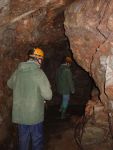 However there was one nasty fall which we were also reminded of while Leila, Ann and David were here. As rain was forecast, we arranged to visit one of the old silver mines outside Sainte Marie-aux-Mines (the town where the Patchwork festival is held). Many years ago we’d visited one of the mines near the town centre. The photo album shows us all (except my mother) togged up in hard hats and waterproofs. Another memorable shot shows my mother taking a photo nearby. It must have been only seconds before she stepped backwards, tripped over a protruding stone behind her, and hit her head, which of course bled spectacularly. Fortunately she didn’t roll into the fast-flowing stream just behind and I think our friend Margrit, who was with us on that visit, thought we were all very callous, as we cleaned up the blood, set her on her feet again and continued our visit.
However there was one nasty fall which we were also reminded of while Leila, Ann and David were here. As rain was forecast, we arranged to visit one of the old silver mines outside Sainte Marie-aux-Mines (the town where the Patchwork festival is held). Many years ago we’d visited one of the mines near the town centre. The photo album shows us all (except my mother) togged up in hard hats and waterproofs. Another memorable shot shows my mother taking a photo nearby. It must have been only seconds before she stepped backwards, tripped over a protruding stone behind her, and hit her head, which of course bled spectacularly. Fortunately she didn’t roll into the fast-flowing stream just behind and I think our friend Margrit, who was with us on that visit, thought we were all very callous, as we cleaned up the blood, set her on her feet again and continued our visit.
On that occasion we had all been shocked by the cramped condition in which the miners worked in the sixteenth century and the slow progress they made with hand-tools. So this time we chose to visit the Gabe Gottes mine which had also been started in the sixteenth century, but enlarged by explosives in the nineteenth and twentieth centuries when not just silver, but also arsenic was sought. We drove behind our guide’s car much further up the wooded hillside to this mine (the whole mountainside must riddled with pits and holes and tunnels from successful and unsuccessful searches). It would have been a really long walk to and from the workings each day. Indeed our guide insisted that more accidents occurred on the way to and from the mines than within them. In a wooden hut, we togged up, and were really glad of the wellingtons, as the tunnels were running with water, and even in these widened tunnels the hard hats and waterproofs were welcome. After threading our way through tunnels, we could see some strange illuminated shapes ahead. A bizarre installation had recently been created by two artists in the deep arsenic pit, entitled “moon garden.” – a creative use of plastic bottles, tubes, bones, metal springs etc.
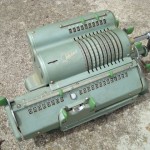 We had also witnessed a creative use of plastic bottles the previous day, Sunday, vide-grenier day. We’d been to three flea markets. At the first small one Dave had bought a magnificent old mechanical calculator from a defunct Saint Dié firm, Leila had bought a Paddington Bear book in French and I’d backed rapidly away from a stall with a snake. At the second fair at Senones we’d looked at old cars, line-dancing and the presentation of wine awards (as well as the remains of the old palaces and monastery), had sampled some pies and wines and Ann had bought some delicious elderflower wine, and I had bought a rhubarb plant. We took the small road over the hills from Senones (which had been so beautiful in the snow two months earlier), to the hamlet of Denipaire, which always includes children’s projects in their flea market. As we settled down to lunchtime chips and sausages, we noticed the rocket stall. Now David is a rocket enthusiast who has built many innovative rockets over the years to launch at an annual Scottish gathering of enthusiasts. So we all went over to inspect and photograph the boys who were launching their plastic-bottle rockets. It all looked much more fun that the hook-a-duck type attractions more usually provided for children at fairs. And we gather that David is now preparing a short article on the Denipaire rockets.
We had also witnessed a creative use of plastic bottles the previous day, Sunday, vide-grenier day. We’d been to three flea markets. At the first small one Dave had bought a magnificent old mechanical calculator from a defunct Saint Dié firm, Leila had bought a Paddington Bear book in French and I’d backed rapidly away from a stall with a snake. At the second fair at Senones we’d looked at old cars, line-dancing and the presentation of wine awards (as well as the remains of the old palaces and monastery), had sampled some pies and wines and Ann had bought some delicious elderflower wine, and I had bought a rhubarb plant. We took the small road over the hills from Senones (which had been so beautiful in the snow two months earlier), to the hamlet of Denipaire, which always includes children’s projects in their flea market. As we settled down to lunchtime chips and sausages, we noticed the rocket stall. Now David is a rocket enthusiast who has built many innovative rockets over the years to launch at an annual Scottish gathering of enthusiasts. So we all went over to inspect and photograph the boys who were launching their plastic-bottle rockets. It all looked much more fun that the hook-a-duck type attractions more usually provided for children at fairs. And we gather that David is now preparing a short article on the Denipaire rockets.
As we looked back through the photo albums, we realised how many activities my mother had participated in, with her camera at the ready to record events like the drainage excavations, the new bath being carried up the ramp, Toby and John installing the new garage door, the Laines sawing up logs for us, the cows ambling between cowshed and pasture, bulbs being planted, trees being felled, games of boules and Toby, Leila and friends on bicycles. There were also lazy-looking lake-side scenes, featuring Alistair’s or John’s canoe, people with books and my mother at her easel. So it seemed very appropriate when Ann and David spent their last day canoeing on lac Gérardmer.
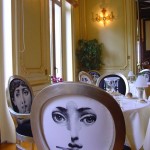 Another tradition was revived the following week when Toby and his girl friend Stella were with us, and got the bikes down from their hooks in the barn, and, punctures repaired, cycled round the villages between rain showers. Toby also remembered the wood fired oven-baked bread we used to get (before dentists’ bills halted our consumption of baguettes), so we made a special stop at that bakery, but alas it was not as good as he remembered. On their first day, Stella’s birthday, we went to the elegant Ducs de Lorraine restaurant in Epinal, but after a rather wet week we thought another meal out would be fun, and we got the last table at the busy Frankenbourg, which is fast becoming a tradition with them, and was pronounced their favourite still.
Another tradition was revived the following week when Toby and his girl friend Stella were with us, and got the bikes down from their hooks in the barn, and, punctures repaired, cycled round the villages between rain showers. Toby also remembered the wood fired oven-baked bread we used to get (before dentists’ bills halted our consumption of baguettes), so we made a special stop at that bakery, but alas it was not as good as he remembered. On their first day, Stella’s birthday, we went to the elegant Ducs de Lorraine restaurant in Epinal, but after a rather wet week we thought another meal out would be fun, and we got the last table at the busy Frankenbourg, which is fast becoming a tradition with them, and was pronounced their favourite still.
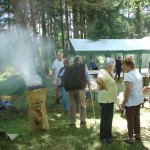 Last Thursday, after all our visitors had left, it was the day of the Sainte Marguerite pensioners’ barbecue, which we’d almost forgotten about. The president of the association owns a wooded family plot beside a small fishing lake, which is ideal for barbecues. Every year the group seem to acquire a new length of tenting, so this year there was enough to shelter tables for 80 guests, and the cold food preparation area, while the aperitif table and smoking barbecue remained outside. There was much discussion of the weather, as rain was forecast for the afternoon. These meals are a great occasion for memories and reminiscence as former neighbours get together, and between the courses we heard about garden crops, wood prices v. oil prices, camping holidays of yesteryear and more recent trips to Tunisia (where the French singing shocked the guide). Pudding must have been served around 3.30 or 4 (one looses track on such occasions) when it was getting cooler, and the first of the rain started. Soon after coffee, the accordion player arrived and the singing started (led by the singer who’d disgraced himself in Tunisia). “I think it’s time to go”, whispered John as a few other people left. We were safely in the car on the way home when the next rain shower hit – but maybe by then everyone back at the lakeside was sufficiently insulated by anoraks, wine and the tent (and perhaps the president’s bottle of potent home-distilled pear liqueur had done the rounds by then), so no longer cared about the weather.
Last Thursday, after all our visitors had left, it was the day of the Sainte Marguerite pensioners’ barbecue, which we’d almost forgotten about. The president of the association owns a wooded family plot beside a small fishing lake, which is ideal for barbecues. Every year the group seem to acquire a new length of tenting, so this year there was enough to shelter tables for 80 guests, and the cold food preparation area, while the aperitif table and smoking barbecue remained outside. There was much discussion of the weather, as rain was forecast for the afternoon. These meals are a great occasion for memories and reminiscence as former neighbours get together, and between the courses we heard about garden crops, wood prices v. oil prices, camping holidays of yesteryear and more recent trips to Tunisia (where the French singing shocked the guide). Pudding must have been served around 3.30 or 4 (one looses track on such occasions) when it was getting cooler, and the first of the rain started. Soon after coffee, the accordion player arrived and the singing started (led by the singer who’d disgraced himself in Tunisia). “I think it’s time to go”, whispered John as a few other people left. We were safely in the car on the way home when the next rain shower hit – but maybe by then everyone back at the lakeside was sufficiently insulated by anoraks, wine and the tent (and perhaps the president’s bottle of potent home-distilled pear liqueur had done the rounds by then), so no longer cared about the weather.
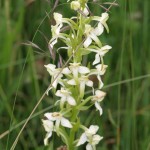 Finally, one of those moving vignettes of county life here. Yesterday we walked with many of the same pensioners (clearly fully recovered from their bucolic fête champêtre) above Corcieux. That area is nostalgic for us, as it is where we were camping that hot summer when we saw our Entre-deux-Eaux house in the estate agent’s window. After about an hour of leisurely walking we approached an isolated abandoned farmhouse, surrounded by a meadow of mauve bistort and white (lesser butterfly?) orchids. And then a white-haired, smiling, gentle old man appeared, clutching a lamp. Despite the shuttered windows the house was not deserted. Now in his eighties, he’d lived there all his life, solitary since the death of his parents, and, more recently, the sale of his cows to neighbours. He seemed delighted to have company passing along the footpath, and chatted about various farms, before waving us on our way. Later we caught up with him taking a box of cat food in his old red car to a neighbouring farm, as his own cat had just died and he wouldn’t be getting another.
Finally, one of those moving vignettes of county life here. Yesterday we walked with many of the same pensioners (clearly fully recovered from their bucolic fête champêtre) above Corcieux. That area is nostalgic for us, as it is where we were camping that hot summer when we saw our Entre-deux-Eaux house in the estate agent’s window. After about an hour of leisurely walking we approached an isolated abandoned farmhouse, surrounded by a meadow of mauve bistort and white (lesser butterfly?) orchids. And then a white-haired, smiling, gentle old man appeared, clutching a lamp. Despite the shuttered windows the house was not deserted. Now in his eighties, he’d lived there all his life, solitary since the death of his parents, and, more recently, the sale of his cows to neighbours. He seemed delighted to have company passing along the footpath, and chatted about various farms, before waving us on our way. Later we caught up with him taking a box of cat food in his old red car to a neighbouring farm, as his own cat had just died and he wouldn’t be getting another.
Oh, just one more rural thought, for those of you who’ve been following the stone marten story with bated breath. The smell in our bedroom was so appalling when we returned after my mother’s funeral, that we just knew that the beast had been very active whilst we were away. In fact we thought a whole family must have been enjoying our hospitality, as the attic was badly soiled as well. So John set to, cut another hole in the bedroom ceiling, scraped out the mess, disinfected, and, when the weather permitted, got out the ladders and blocked up all the accessible gaps under the eaves with bricks, chicken wire and cement, and … ordered a trap. We left the mess in the attic, to preserve the marten’s favourite scent, and when the trap arrived, John baited it with an egg and put it in the attic. The first night the egg vanished, but there was no occupant in the trap. After the second night, however, the trap contained a small hissing and shrieking furry animal. It would have looked quite sweet, were it not for the sharp teeth with which it snapped viciously at anything that approached. We didn’t think that any farmers or hen-keepers would be happy if we released it some distance away from us. And indeed Farmer Duhaut had no questions in mind about its fate when he turned up with his rifle. Despite my vegetarian upbringing, I could feel no regrets, as I set to with scraper, scrubbing brush and disinfectant to clean up its attic legacy. But that may not be the end of the story as our invader (variously christened “Fluffy”, “Cuddles” or “Cyril”) no doubt has siblings and parents out there somewhere.

